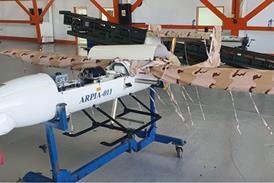Lockheed Martin and the US Defense Advanced Research Projects Agency (DARPA) launched a new prototype long-range anti-ship missile (LRASM) on 27 August. Unlike other cruise missiles, the LRASM is designed to autonomously guide itself to its target without extensive prior target data, using its own sensor suite.
"It is the first time we've taken a sensor suite of this sort - the first time anybody has done this - and integrated it into a closed-loop system of the missile so it can autonomously detect, track and engage the threat," says Artie Mabbett, DARPA's programme manager for the LRASM project. "And that just completed about a week and a half ago."
The flight test was conducted from a Boeing B-1 bomber operated by the US Air Force. Prior to the launch test, DARPA had conducted numerous captive carry events over several months to gather data, Mabbett says. Most of those tests, which were conducted on board a business jet, were designed to test the LRASM's sensor systems.
Once the captive carry tests were completed, the sensors were integrated into a Lockheed AGM-158B Joint Air-to-Surface Standoff Missile-Extended Range (JASSM-ER) for the 27 August test, Mabbett says. While the LRASM's sensor suite is new, the underlying system is heavily based on the JASSM-ER.
"Essentially what we have done is taken a basic waypoint-following cruise missile concept and added brains to it," Mabbett says. "We've put in the capability so that it can autonomously now detect, contract and engage the targets of interest without having being dependent upon lots of apriority knowledge."
DARPA and the US Navy's Office of Naval Research (ONR) plan to conduct two additional tests of the air-launched LRASM variant over the next few months. The objective of those flights will be to further vet the maturity of the missile's sensor system in a more challenging environment, Mabbett says. Those tests will stress different ranges, altitudes and geometric approaches to the target.
Follow-on activity will focus on a surface-launched variant of the weapon, which will be launched from the vertical launch cells of a USN warship like the Arleigh Burke-class destroyer or Ticonderoga-class missile cruiser. "We will be doing two launch events next summer to demonstrate that capability," Mabbett says.
Mabbett adds that there is also significant USN interest in a submarine-launched variant of the LRASM. While the DARPA/ONR programme does not have a requirement to demonstrate underwater launch capability, if the weapons can survive the rigours of a warship's launch cells, it should be simple enough to adapt the missile for submarines, Mabbett says.
Ultimately, LRASM will be among the contenders for the navy's nascent offensive anti-surface warfare effort, Mabbett says. While the LRASM programme was created as a specific response to emerging threats, Mabbett says he cannot elaborate on the nature of those threats. However, he hints that the underlying threat is enemy electronic warfare systems.
Source: Flight International























